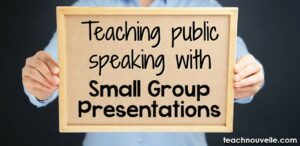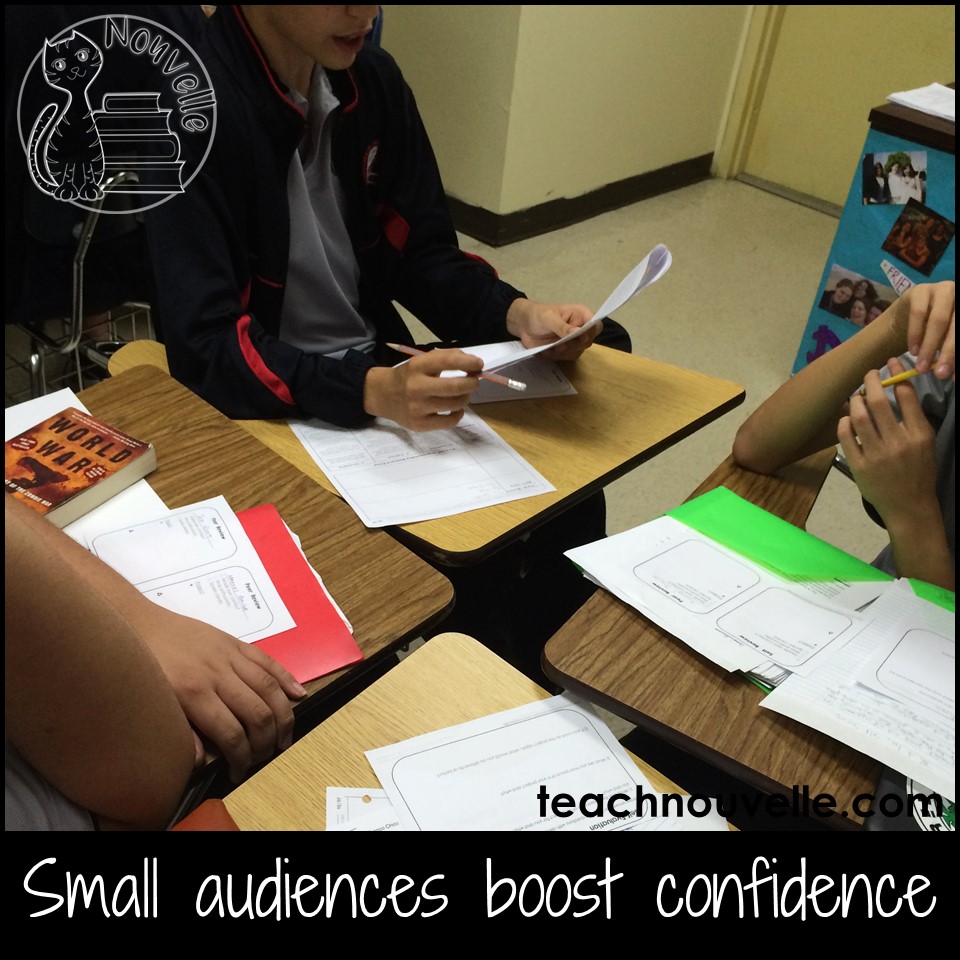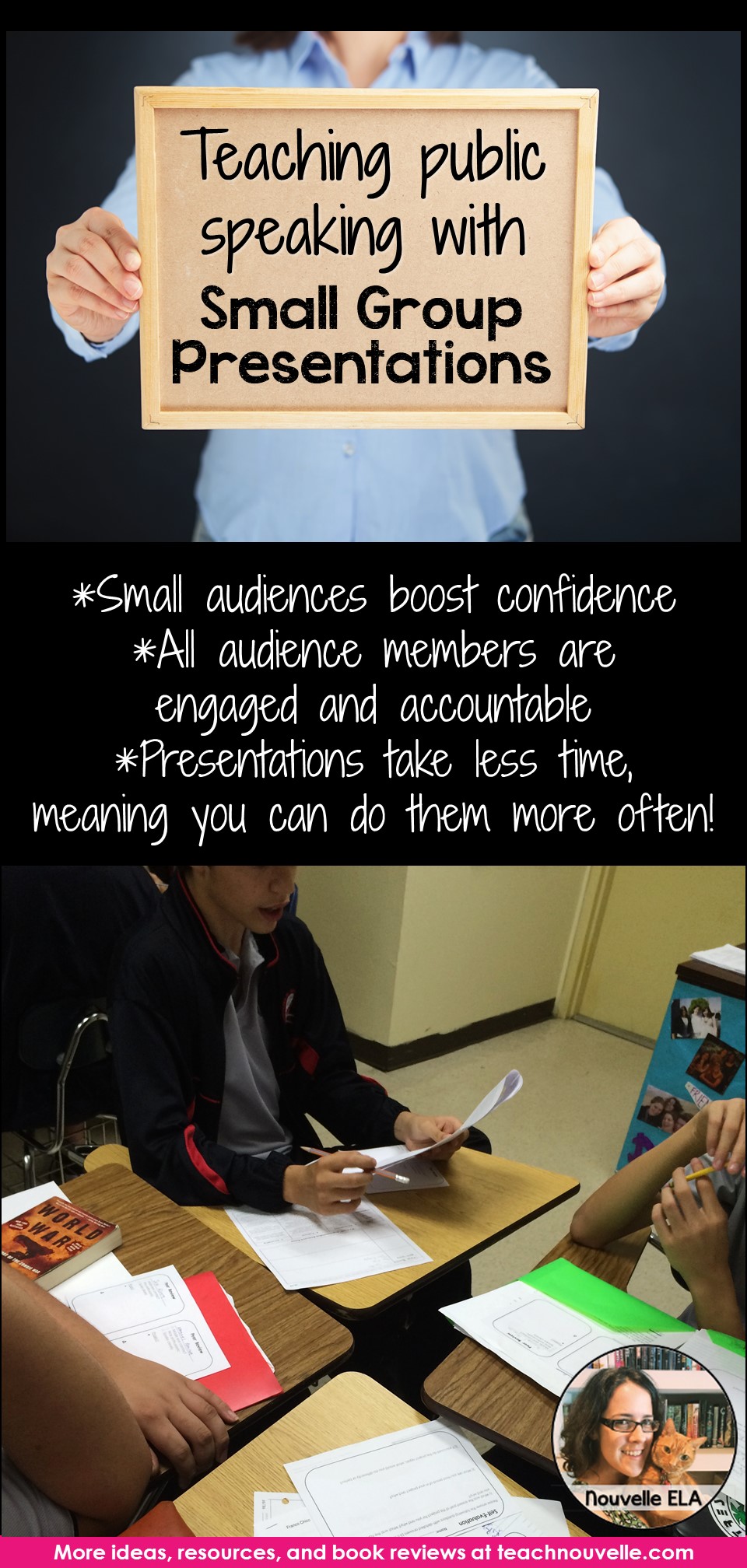Teach Public Speaking with small group presentations to boost speaker confidence, keep the audience engaged, and improve usage of class time.
Public Speaking is an important skill for middle schoolers and high schoolers to develop, and some of them embrace the opportunity. For others, though, public speaking can be so daunting as to actually cause fear and nausea.
How can we help our students develop public speaking and listening skills while still being respectful of their feelings?
Small group presentations.
Rethinking my presentation model helped alleviate my students’ fears, increase audience engagement, and save valuable classroom time.
How it Works
Instead of having students present in front of the whole class, put them into presentation groups of 5-6. Make sure someone is still timing each speaker (1-2 minute presentations are a great starting point!), and make sure that you can circulate to hear every group.
Students begin presenting a practiced speech, just as they would for the whole class. Presentations will happen simultaneously, so you will not be able to hear every second of every presentation. Instead, you can have students complete Peer Evaluation Slips.
These slips will ask students to assess their peers on articulation, eye contact, and voice. This will help you assess the public speaking portion of the assignment, while still maintaining control (if that’s your style) of grading the content of the research assignment, etc.
Alleviate Student Fears
Students will be much more at ease with public speaking if only four other people are listening. You can also set up low-risk presentation groups ahead of time. You can use the same presentation groups all year or gradually grow your groups.
For example, consider eventually leading your students to whole-class presentations:
1st quarter: weekly or bi-monthly presentations (6 groups of 5)
2nd quarter: weekly or bi-monthly presentations (4 groups of 7-8)
3rd quarter: bi-monthly presentations (3 groups of 10)
4th quarter: one presentation (2 groups of 15), two presentations whole-class
Want more ideas?
Here’s how I use improv games to build student confidence!
Increase Audience Engagement
It’s easy for audience members to drift off when they have the anonymity of being one of thirty listeners. It’s not so easy to get away with this if the audience is only made of four people! Small group presentations are the perfect way to keep other students engaged and active.
Students can support each other by giving feedback after all of the presentations are complete. If your school allows devices, enlist a student to film the speakers on their own phones. Then, each student will be able to privately review his/her presentation and look for things like posture, eye contact, articulation, etc.
Also, students won’t have to sit through as many presentations, so they are more likely to enjoy the whole experience.
Want to save big on Peer Feedback resources?
Check out my bundle!
Save Classroom Time
Simultaneous presentations save a LOT of classroom time, meaning that you can increase the overall number of presentations you do in a year.
If you’re like me, you’re used to blocking out at least two class periods for project presentations and even more for solo speeches. This might work once a quarter, at most, but is it really helping our students improve?
If you allow simultaneous presentations and give students three minutes (and two for peer comments, if you want), you’re looking at a max of 25 minutes with groups of five students.
Find 20-25 minutes for public speaking twice a month, and your students will improve very rapidly.
Other Ways to Strengthen Students’ Public Speaking Skills
One way to lower the pressure of teaching public speaking skills online or in the classroom is by using children’s books as inspiration.
Middle and high schoolers will become much more confident with this approach to public speaking.
Why are children’s books great for middle and high schoolers?
- Students can read them in a class period and get to work
- If they want to choose a different text, there’s not a ton of lost time
- Students can connect to the story AND to the artwork
Teaching Public Speaking Skills
I’ve been teaching public speaking to 8th and 9th graders for a long time now, and I can tell you that the number one thing they need is CONFIDENCE.
Therefore, I always look for ways to build confidence. Here are some key ideas to build confidence and how children’s books fit into the equation.
1. Students need a lot of opportunities to practice their public speaking skills.
Short, frequent, low-stakes practice is key.
You could choose one day a week where you’ll focus on teaching public speaking, one skill at a time. Perhaps one week is “making eye contact with the audience” and another week is “speaking without note cards.
If all of their public speaking eggs aren’t in one Major Project basket, they’ll feel more successful.
Idea: Have students read a children’s book of their choice and present it to a small group (4-5) in a short Book Talk.
What did they love? Which page had their favorite artwork? You can give students questions and help them brainstorm and practice a 3-4 minute Book Talk they’ll share with their small groups.
I have a free resource for Book Talk Brainstorming to make your life easier 🙂 You can repeat this activity several weeks in a row with different books or the same book with different groups.
If you’re teaching public speaking online, students can practice these skills in breakout rooms.
2. Students need to feel relaxed.
One of the best tools I’ve found for teaching public speaking is by using improv games in ELA.
These drama games help students think on their feet and connect with their costars. Best of all, the gamification of it lowers the stakes and helps students feel relaxed.
Idea: Have students work in small groups to read a children’s book. Then, they’ll recreate that children’s book in a short skit in front of the class.
This is a great way to help students relax since they aren’t inventing the story – they’re retelling. They also have the comfort of being part of a team as they practice their public speaking skills.
3. Students need to hear what they’re doing well.
Part of building student confidence with public speaking is giving a lot of positive feedback. And it doesn’t just have to be from you, the teacher.
Students should be ready to share what their peers are doing well. (The laughter students get from improv games is also a form of positive feedback)
One resource I recommend is this bundle of Peer Feedback forms. These are short and easy and focused on the positive. 🙂
Students can complete these in small groups, too, so you don’t have to subject students to the terror of talking in front of 29 peers as they hone their skills.
Idea: Students choose a children’s book to read aloud in small groups. This provides them an opportunity to practice pacing, adding vocal interest, and even “looking up from their notes.”
This is a task that they can rehearse at home or in class a few times without a huge time commitment. Plus, it’s a fun day of class!
If you’re teaching public speaking online, you can easily record this activity and share it via Flipgrid or another platform.
Low-stress Public Speaking Activities
Back to School Peer Interview Project
Students brainstorm open-ended questions and use them to interview a classmate. Then, they present to their classmates in very short presentations.
I really love this activity because it helps students understand open-ended vs. close-ended questions. It is also quick and easy and helps jumpstart your classroom community.
Students can use this back-to-school activity to identify their own assets — an excellent way to counter deficit-based thinking that middle and high school students often have.
Once they create their profiles, they can present them in small group presentations. Sign up for my emails to score a freebie of this activity!
Be sure to check out my Back to School Activities Bundle!
Public Speaking Tips for Students
I have had a LOT of fearful students tackle public speaking in my classroom.
Here are some tips I share with all students, along with my ideas for the most nervous speakers.
- Do a warm-up with all students.
- Stretch – have all students stand up before presentations start and do a few stretches. Stretches that cross the midline of the body are particularly grounding.
- Breathe – my favorite centering sort of breathing is called “double nostril breathing.” Cover one nostril and breathe deeply through the other nostril. Breathe out. Switch. Repeat 5-10 times.
- Start with small-group presentations.
Instead of having students present one at a time in front of the whole class, start practicing public speaking by having students present to a group of 3-4 peers.
As the school year progresses, you can increase this audience until you have full-class presentations. Read more about this strategy here.
If you have a truly fearful student, I’d start the year on the right foot by offering them the opportunity to present at lunch or after school.
Have you already tried Small Group Presentations to improve your students’ public speaking? What worked for you? Let me know in comments.








No Comments